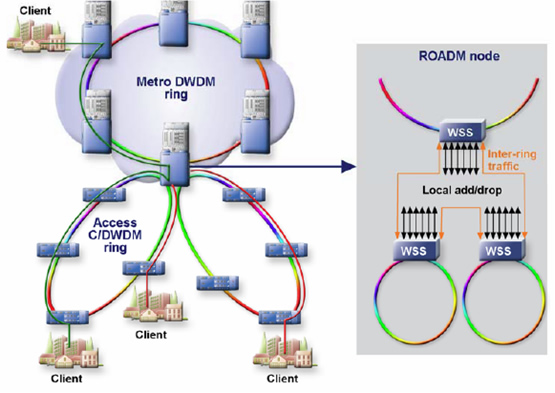WSS and ROADM
2025-04-19
What Is a Wavelength Selective Switch (WSS)?
A Wavelength Selective Switch (WSS) is a critical component in optical communication systems, designed to dynamically route and manage wavelengths in Dense Wavelength Division Multiplexing (DWDM) networks. WSS devices allow network operators to selectively switch optical signals of specific wavelengths from one port to another, enabling flexible wavelength routing without the need for optical-to-electrical conversion.
WSS typically employs technologies such as Liquid Crystal on Silicon (LCoS) or Micro-Electro-Mechanical Systems (MEMS) to manipulate optical signals. The device disperses incoming optical signals into their constituent wavelengths using a diffraction grating. These wavelengths are then directed to specific output ports based on the configuration of the switching mechanism. Modern WSS systems support colorless, directionless, and contentionless (CDC) operations, which enhance network flexibility by allowing any wavelength to be routed to any port without restrictions.
WSS is widely used in long-haul, metro, and data center interconnect (DCI) networks. Its ability to dynamically allocate wavelengths makes it indispensable for applications requiring high bandwidth and low latency, such as video streaming, cloud services, and real-time data analytics.
What Is a ROADM?
A Reconfigurable Optical Add-Drop Multiplexer (ROADM) is an advanced optical device that allows network operators to add, drop, or pass through specific wavelengths at a network node without manual intervention. Unlike traditional Optical Add-Drop Multiplexers (OADMs), which require fixed wavelength assignments, ROADMs offer remote reconfiguration, making them a cornerstone of modern optical networks.
A typical ROADM consists of WSS modules, optical splitters, and multiplexers/demultiplexers. The WSS serves as the core switching element, enabling wavelength selection and routing. ROADMs can be configured in various architectures, including:
Fixed ROADM: Supports predefined wavelength add/drop configurations.
Colorless ROADM: Allows any wavelength to be added or dropped at any port.
Directionless ROADM: Enables wavelengths to be routed to any direction without physical reconfiguration.
Contentionless ROADM: Prevents wavelength conflicts by allowing multiple instances of the same wavelength to be added or dropped.
ROADMs are deployed in various network segments, including long-haul backbone networks, metropolitan area networks (MANs), and access networks. They are particularly valuable in scenarios requiring frequent wavelength reconfiguration, such as disaster recovery, traffic load balancing, and network upgrades.
The Synergy of WSS and ROADM
WSS and ROADM are complementary technologies that work together to create agile and efficient optical networks. The WSS serves as the enabling technology within ROADM systems, providing the wavelength routing and switching capabilities that make ROADMs reconfigurable. Together, they address the key challenges of modern optical networks: flexibility, scalability, and cost efficiency.
Enhancing Network Flexibility
The combination of WSS and ROADM enables CDC functionality, which is critical for next-generation optical networks. Colorless operation allows any wavelength to be assigned to any port, directionless operation supports flexible routing to any network direction, and contentionless operation eliminates wavelength conflicts. This CDC capability ensures that networks can adapt to dynamic traffic demands without costly hardware upgrades.
Supporting High-Capacity Networks
As data rates increase, WSS and ROADM systems are evolving to support higher-capacity channels. For example, modern WSS devices can handle flexible grid spacing compatible with super-channels, which aggregate multiple wavelengths to achieve terabit-scale data rates. ROADMs, in turn, facilitate the seamless integration of these high-capacity channels into existing network infrastructures.
Enabling Software-Defined Networking (SDN)
The programmability of WSS and ROADM aligns with the principles of Software-Defined Networking (SDN). By integrating with SDN controllers, these devices allow network operators to automate wavelength provisioning, optimize resource allocation, and respond to real-time traffic demands. This automation reduces operational complexity and enhances network efficiency.

Application Scenarios of WSS-ROADM Systems
WSS-enabled ROADM systems are now widely deployed across metro, regional, and long-haul networks. Here are some typical use cases:
Metro Optical Networks
High-capacity, low-latency metro networks benefit from ROADM flexibility to aggregate and distribute traffic from data centers, 5G base stations, and enterprise users.
Long-Haul Backbone
In national or international backbones, ROADM nodes enable mesh topologies with automatic protection switching, allowing faster recovery from fiber cuts.
Data Center Interconnect (DCI)
ROADM systems allow large data centers to scale bandwidth dynamically and optimize routes for low latency and high reliability.
5G xHaul Transport
WSS-ROADM enables dynamic allocation of bandwidth and paths to support the varying traffic demands of 5G front-haul, mid-haul, and back-haul segments.
Multilayer SDN Networks
With centralized SDN controllers, WSS-ROADM nodes can be programmed to adjust optical paths in real time, enabling true multi-layer optimization.
As operators strive toward intent-based networking and zero-touch automation, WSS-based ROADM architectures are poised to play an even greater role. Emerging advancements such as pluggable coherent optics, AI-assisted network optimization, and elastic optical networks will further increase the reliance on programmable photonic switching elements like WSS.
GLSUN is a leading manufacturer of LCoS-based Wavelength Selective Switches (WSS), offering high-performance modules that enable flexible grid spacing, polarization-independent operation, and seamless integration into CDC-ROADM architectures.







